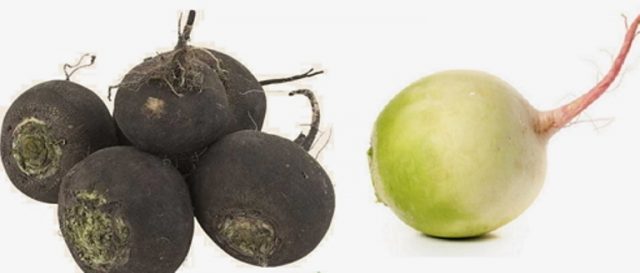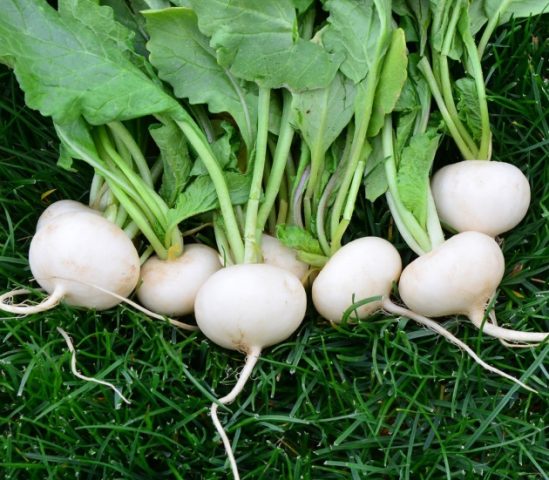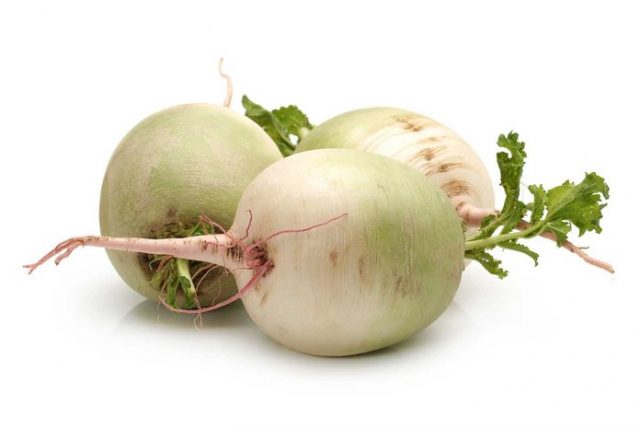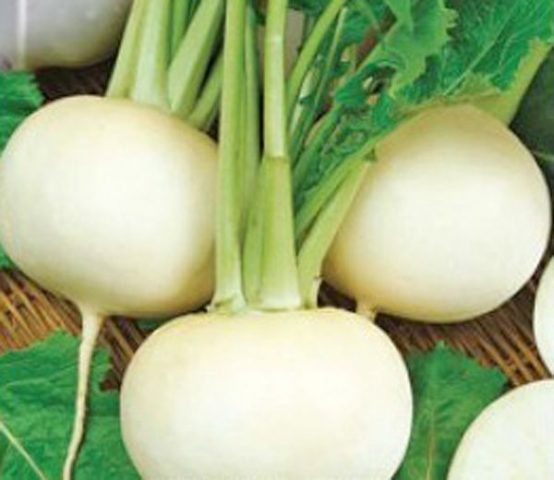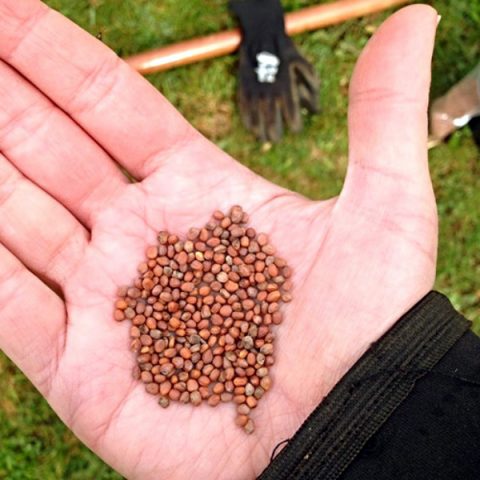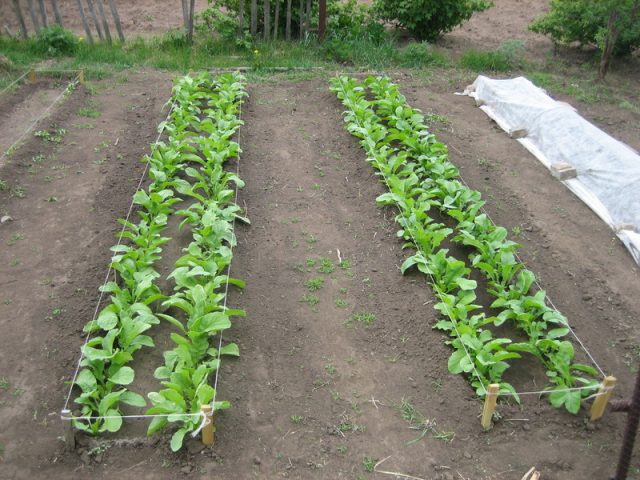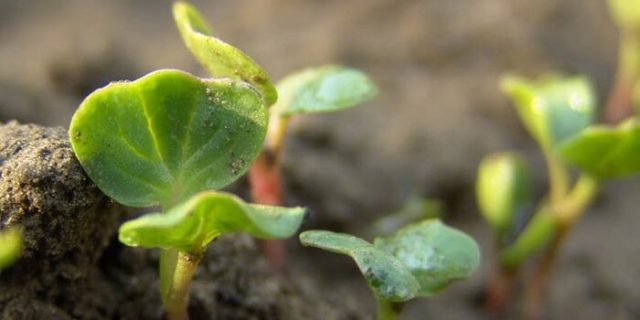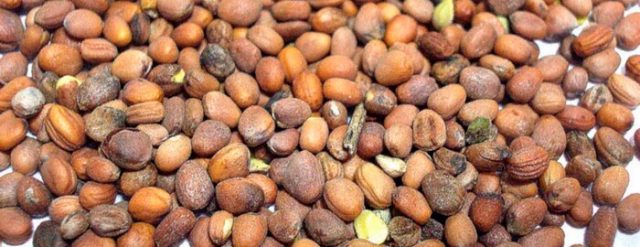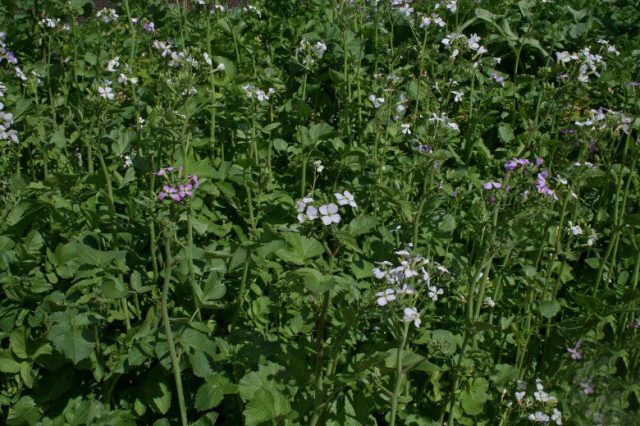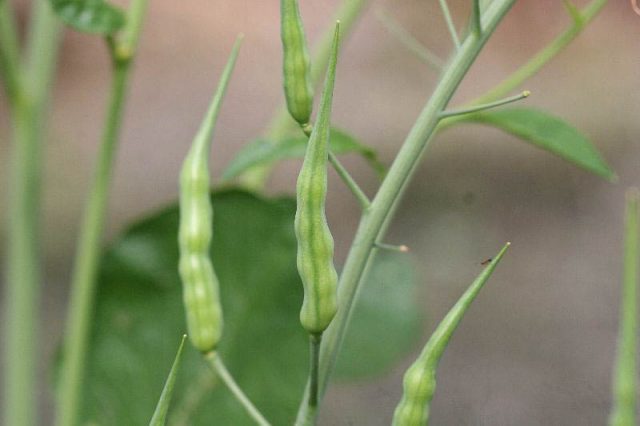Content
Black and white radish are the sharpest of all representatives of the Sowing radish species. The culture has been cultivated for thousands of years in the East, from where it spread to Europe. In Russia, a hundred years ago, the root vegetable was no less popular than carrots and was considered an ordinary food. Planting black radish in open ground today has become much less common, but in vain.
This member of the cruciferous family may not be very tasty if you just peel and cut off a piece of root vegetable. But with skillful preparation, radish can become an appetizer, a side dish and even a sweet-spicy dessert. And even those who have no idea what it looks like know about the beneficial properties of the root crop.
When to plant radish in open ground with seeds
Planting and caring for radishes outdoors differs depending on the variety. The skin of early root crops is usually white, late ones - black. This radish is round, at an early age it easily takes root in a new place, therefore, it can be grown through seedlings. This simply does not make sense, with the right choice of planting dates, it ripens perfectly when sowing seeds in the ground.
Radish is a plant of short daylight hours. At the beginning or end of the season, it forms a root crop and builds up its green mass. As soon as the day is longer than 12 hours, the plant begins to prepare for fruiting and throws out the flower arrow. From this, the root crop becomes hollow and unsuitable for food.
It turns out that all types of radish need to be sown, grown and harvested at the very beginning of the growing season, or closer to its end.
Planting dates for radish in early spring
White radish has a much milder flavor than black radish. It is somewhat sharper than a radish and forms a large or medium root crop. White varieties are considered early, they are called summer and are planted in spring, when the soil thaws and warms up a little. This usually happens in April, in the North by the end of the month, for the southern regions - at the beginning.
Summer radish is an annual crop that forms a root crop and produces seeds in the same year. From the moment of emergence of seedlings to technical ripeness, an average of 50 to 60 days pass. This is much longer than that of radish, but shorter than the growing season for black radish. Summer varieties are not suitable for storage, they are grown specifically for fresh consumption.
Seeds of white radish are planted very early, they germinate at a temperature of 5-10 ° C. The culture is not afraid of short-term frosts and has time to give the harvest before the day becomes longer than the night. In most regions, by this time, the temperature does not have time to become critical and provoke flowering.
When to plant winter radish
The timing of planting black radish and its care depend on the growing season. And the culture grows for a long time, on average 90 days. There are varieties with a ripening period of up to three months. Black radish is perfectly stored in winter, and the longer the period from the moment of germination to the stage of technical ripeness, the better.Varieties with the longest growing season can lay up to eight months without loss of marketability.
Given that the culture tolerates light frosts, it may seem as if it needs to be planted as late as possible. But root crops caught under negative temperatures lose keeping quality and quickly deteriorate.
The timing of sowing black radish must be correlated with the climate of the region. It must be planted in such a way that the roots begin to form by the time the daylight hours become shorter than 12 hours. You need to dig out winter varieties before the onset of frost, and in dry weather. So it's not enough to be guided by temperature and light. It is necessary to take into account the characteristics of the climate.
In the south, black radish seeds are planted in the second half of July or early August. In the Moscow region - no later than the beginning or mid-July, for the Middle Lane, the sowing dates are shifted to the end of June - the beginning of July.
When to plant radish in Siberia
In the Northwest and Siberia, black winter radish is planted in early June. As long as it rises and begins to form a root crop, the daylight hours will become shorter.
Is it possible to plant a radish before winter
Planting radish before winter is possible. But does it make sense? Podwinter sowing is done in order to get fresh vegetables or herbs as early as possible, and not with the aim of experimenting with seedlings.
To clearly understand why radish is not worth sowing before winter, it is better to disassemble everything point by point.
- Radish seeds germinate quickly even at low temperatures. At 4 ° C, after 14 days, seedlings appear above the surface of the soil, and hatch even earlier. In those regions where winter thaws are possible, there is no point in sowing radish - it will germinate and then die safely when the temperature drops for a long time. In the North and beyond the Urals, you can simply miss the time of planting seeds.
- Even if the seedlings appeared in early spring, they can be destroyed by return frost. Germination temperature is rather low and unstable at the beginning of the season. A short warmth gives way to frost, this is normal for early spring.
- Suppose that the radish survived the winter safely, germinated in time and was not destroyed by low temperatures. As soon as the soil warms up a little, in March or early April, a cruciferous flea that has wintered there will come out of the soil. The hungry insect usually settles on wild rape, yarut or other cruciferous weeds. Too early shoots of a cultivated plant will be completely destroyed by a flea, since they are a delicacy for a pest. The end.
Of course, it is possible to grow radish from podzimny crops. But the effort expended will not be equal to the result. And if you consider that potent chemicals will need to be used to combat the cruciferous flea at the beginning of the season, the benefits of early root crops will become doubtful.
Which variety to give preference
As of the end of 2018, there are 28 varieties of black and white radish in the State Register. In fact, there are much more of them. To choose the right varieties of black and white radish, you need to take into account the region where the crop will be grown and the timing of its consumption.
Selection of varieties depending on the region
Radish varieties included in the State Register are recommended for cultivation throughout Russia. They are simply planted a little earlier or later to adapt to the local climate.
It could be written that the most frost-resistant varieties are grown in the North, and those that are not prone to shooting are chosen for the South. But in fact, round white and black radish gives a good harvest everywhere, you need to dig it up, regardless of the region, before the thermometer shows freezing temperatures. And the peduncle will in any case form when the day is greater than the night, or in extreme heat, in contrast to radish, which has varieties that are resistant to shooting.
Selection of varieties by ripening and storage periods
For fresh consumption, varieties of white radish are chosen, which are planted in early spring. They are not stored and unsuitable for processing, but they have a milder taste than winter ones. You can recommend growing these early varieties:
- Agate with a white conical root vegetable weighing up to 400 g, ripening - 50-60 days;
- A delicacy with a convex head weighing up to 50 g and ripening in 38-40 days;
- Bianca with small (up to 45 g) flattened heads, ripening - 40-42 days;
- Maiskaya - a white root crop, flattened, weighing up to 100 g, ripening - 55-65 days;
- Munich Beer - a variety with an oval white root vegetable weighing up to 400 g, ripening in 55-60 days;
- Sirius is the newest high-yielding variety, with a conical white root vegetable weighing up to 65g and ready to harvest 38-40 days after germination.
There are varieties that can be stored for a month or a little longer. They are considered late autumn, but not because they are planted in the summer, but because of the shelf life - they are eaten fresh or kept until the beginning of winter. Such a radish will not be stored longer. The best varieties:
- Astronomer with pink skin and conical roots weighing from 75 to 330 g, ripening in 65 days;
- Autumn Luck - a variety that ripens in 72-75 days, with rounded white roots and weighing up to 270 g;
- Matchmaker with a flattened white root vegetable, weighing up to 150 g, ripening period - 52-55 days.
Radish varieties for winter storage are usually (but not always) distinguished by black skin, pronounced bitterness and the highest content of nutrients. The longer their ripening period, the better the keeping quality of root crops. You can recommend the following varieties for growing:
- Uncle Chernomor - a new variety that ripens in 55-60 days with a flat-round black root vegetable, white pulp, moderately pungent taste and weighing 200-220 g;
- Winter round white - an old proven variety with excellent keeping quality, ripening in 80-100 days, with a round head, white skin and a pungent taste;
- Winter round black - perhaps the most famous old variety, ripens in 70-110 days, with black peel and white pulp, rounded root vegetable weighing 250-550 g, pungent taste, long shelf life and high content of nutrients;
- Misato Grin - French winter variety, distinguished by good taste, white-green skin and triangular root vegetable weighing 350-450 g, ripening - 50 days;
- Night it is considered one of the most delicious winter varieties, ripens in 68-75 days, a rounded black root crop, up to 220 g;
- Cylinder It stands out among other varieties with a conical long black root crop, similar in shape to a daikon, ripens in 62-73 days, weight - up to 210 g.
Planting radish in open ground with seeds
The easiest way to sow radish is directly into the ground. Even varieties with round root crops, which can be transplanted at a young age, do not make sense to grow through seedlings.
Soil preparation
The soil must be dug deep before, for summer varieties from autumn, for winter varieties - at least 2 weeks in advance. Since alkaline or neutral loose soils are ideal, the structure is improved if necessary with sand, peat or mature compost. Acidity is normalized with lime.
Fresh manure cannot be applied - an excess of nitrogen will lead to active growth of greens to the detriment of the root crop, the formation of voids in it, a decrease in keeping quality and a deterioration in taste. Before sowing winter radish, which is carried out in the middle of summer everywhere, except for Siberia and the North-West, onions can be grown on the site for greens, spinach or dill. Do not plant lettuce or other cruciferous crops there.
How to plant a radish
Round black and white radish are sown in the furrows. They are made 3-4 cm deep, a glass of ash and 3 tablespoons of complete complex fertilizer are added per 1 running meter, mixed with the soil and watered abundantly. The rows should be spaced 30 cm apart.
After that, seeds are sown, and the larger the root crop, the less often. Then the planting is covered with a layer of soil 1.5-2 cm. So it will be easier for the seeds to ascend - a crust does not form on the surface of the soil after watering, besides, they will not be washed out with a stream of water. There is enough moisture in the furrows after pre-wetting.
Then the seedlings will be thinned out several times, and in the early stages the seedlings can be moved to a new place, and in the later stages, young roots can be eaten. 1 g contains 100-120 radish seeds, so there should be no problems.
But if necessary, you can grow a crop by planting not in furrows, but in nests. 2-3 seeds are sown in them, in the phase of 2-3 true leaves one sprout is left. The distance between the holes is at least 15 cm. But for a radish with large roots, it should be large.
Growing radish outdoors
What does round bitter radish like? In order for the root crops to be tight, juicy, and in winter black varieties to lie for a long time, the culture needs:
- good lighting for no more than 12 hours a day;
- regular watering;
- top dressing, mainly potash fertilizers;
- cool weather;
- loose soil.
Radish does not like:
- long daylight hours;
- heat;
- fresh manure;
- large doses of nitrogen fertilizers;
- dense acidic soils;
- thickened fit;
- drying out of the top layer of the soil.
White summer radish, if the soil was filled before sowing the seeds, not only with ash, but also with complex fertilizers, can not be fed. You need to water the culture regularly so that the soil does not have time to dry out completely, otherwise the pulp will be dry, fibrous and tasteless.
If necessary, the garden bed is covered with black agrofibre or lutrastil after 7 pm to restrict access to light. The aisles are cleared of weeds and loosened regularly. Thickened plantings are thinned out.
How to grow black radish outdoors
Growing and caring for black radish has its own nuances. First of all, this applies to dressings. Black late varieties are intended for long-term storage, they must accumulate the necessary nutrients for this.
The first dressing of the radish is given at the stage of formation of 5-6 true leaves. At the same time, a complete complex fertilizer is used, preferably one specially designed for root crops. The second feeding should not contain nitrogen and is done at the stage of the beginning of the formation of the root crop. You can replace mineral fertilizers with ash - it is rich in potassium, and it is this substance that the radish needs more than others.
Otherwise, everything is as for the early varieties: loosening, weeding, milk of lime, regular watering, which is stopped 3-3.5 weeks before harvesting.
How to get radish seeds
To get the seeds of summer radish, it is better not to leave it in the garden, but to dig it up, wash it, prepare it and plant it back into the ground. They do this in order to choose the best root crops that meet varietal characteristics.
The radish is dug up, cleaned of soil, cut off all the leaves, except for the central ones, soaked in water. To obtain seeds, a root crop is suitable, which will drown, and the one that has emerged to the surface is discarded.
Plant the radish in the ground in a sunny place. She is ready for harvesting when the pods turn yellow and the seeds turn brown. Now the plant is pulled out and placed in a dark, well-ventilated place for ripening.After 12-15 days, the pods should burst easily, they are threshed, sifted and poured into a paper bag with ventilation holes, on which the year of harvest is inscribed.
When to plant black radish tubers for seeds
Winter black radish, which has a two-year life cycle, is planted the next season after harvesting. If she went to the shooter early and managed to give seeds in the year of planting, it is better to throw them away. High-quality radish will not grow out of them.
To obtain seeds, the best root crops are chosen, corresponding to varietal characteristics, and stored separately from the rest of the harvest, and planted in the garden in late spring.
Black radish seeds are harvested and stored as described above.
Why does the radish go to the arrow and what to do
Radish most often goes to the arrow due to violation of planting dates. When root development occurs with long daylight hours, flower formation cannot be avoided. The only thing that can be done is to regulate the illumination by covering the bed with black lutrastil or agrofibre.
The high temperature also contributes to the formation of the flower arrow. Here you really need to be guided by the climatic features of the region before planting the radish. You can help a little by increasing watering. But you cannot drown a radish in water.
Lack of moisture makes the plant strive to complete its life cycle as soon as possible and give at least some seeds. Watering the radish should be regular and abundant.
An excess of fertilizers, especially those containing nitrogen, makes the root crop hollow, fibrous, and stimulates flowering. Excess fertilizing radish is not only unnecessary, but also harmful. You can not bring fresh manure under the culture or fill the soil immediately before planting with humus.
Dense, heavy soil alone is unsuitable for growing radishes and can speed up the formation of flower stalks.
It is easiest to deal with thickened plantings - they just need to be thinned out. Moreover, small plants can be planted on a new bed, and those that have already managed to form a root crop can be eaten.
Radish diseases and pests: control and prevention measures
The radish is almost not sick. On acidic soil, cruciferous plants can form a keel, which is fought by watering the plants with milk of lime. Constant overflow, coupled with dense soils, can cause rot.
But the radish is in trouble with pests - it is affected by all insects characteristic of cruciferous crops. As a preventive measure, it is advisable to sprinkle the soil with dry ash after watering, lay out wormwood in the aisles.
If the pests have already appeared, you can use tobacco dust, spray the garden with an infusion of wormwood or red pepper. It is impossible to use karbofos, as some sources advise! This drug is so toxic that it is banned in Europe, but in our country it is used because of its high efficiency.
Conclusion
It is necessary to plant black radish in open ground on time. If you focus on the requirements of the variety and your own climatic conditions, there will be no problems with the culture.
